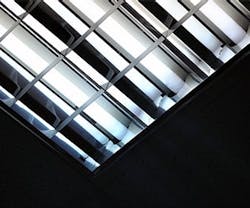Are Linear LED Retrofits Worth the Investment?
LED retrofits are efficient and effective replacements for linear fluorescent lamps in troffer fixtures, but may not be cost-effective for FMs who need a short payback period, the GSA notes in a recent field test of linear LED retrofit products.
The agency tested two retrofit products that pair proprietary light bars with matching proprietary drivers. Intended to replace existing static lighting systems one-for-one, both linear LED products are 0-10V dimming capable and can reduce light output, but differ in the way the light bar attaches to the fixture housing. The first, referred to throughout the study as LED-A, mounts the light bar to the top of the fixture housing, while the other (LED-B) utilizes the existing fluorescent lamp sockets as an electrical and mechanical interface. Both are designed to last 50,000 hours.
Both product types were tested at three sites: a regional headquarters facility in Auburn, WA, the Cabell Federal Building in Dallas and the Veterans Administration Center in Philadelphia. GSA’s aims were to capture energy efficiency, photometric performance, occupant response and cost-effectiveness.
Energy Efficiency
Installed technologies and conditions varied widely at the project sites, the GSA notes in its project findings. Mixes of nominal and reduced wattage lamps, two- and three-lamp fixtures and varying ballast technologies and manufacturers were common, making it difficult to compare the LED replacements against the old fixtures. The readings were normalized for analysis by assuming the high end of the industry-accepted range in wattage for two-lamp T8 fixtures with electronic ballasts (60W) as the pre-retrofit condition.
LED-A and B used 44W and 42.9W respectively, indicating a savings of 26.7% and 28.5% over the assumed 60W baseline.
Photometric Results
Both linear LEDs delivered higher initial light levels when installed in one-for-one applications, and light uniformity improved in some sites, the report notes. This result was expected as the existing fluorescents in all spaces were at various stages of lumen and dirt depreciation.
In several locations, delamping from three lamps to two was necessary because the space was overlit. This prevents GSA from making a direct comparison but indicates that the LED replacements could help address overlighting by allowing delamping while still providing adequate illumination, potentially leading to greater energy savings.
Occupant Response
Pre- and post-installation occupant surveys at all three evaluation sites revealed several observations about light levels and glare.
At the Auburn, WA, Regional Headquarters Building, where the LED products were studied in two first-floor office spaces, occupants thought the lighting was too bright; this could have been due to its newness, as it hadn’t depreciated due to dirt and age like the fluorescent system. Occupants also thought both lamps presented a higher potential for glare on work surfaces and in distance viewing, but not on computer screens.
Higher glare potential was also an issue at the Dallas evaluation site, the office sections on the seventh floor of a federal building. Both LED-A and LED-B products achieved less glare on work surfaces, and LED-A also created less glare from overhead lighting.
The Philadelphia evaluation was conducted in a daycare facility on the lower level of a Veterans Administration Center. The LED retrofits here created higher glare potential like at the other sites. All of the differences for light levels and glare were slight, but individual occupants may notice issues no matter what. For example, people at the Dallas site complained of low light levels in one area, likely due to the different light output in the installed lamps – a higher wattage lamp would have likely solved the issue.
Cost-Effectiveness
The report declares both products cost-effective using the national average energy rate of 10 cents per kWh. However, that conclusion reflects a payback of 7.3-8.2 years for LED-A and 7.1-8 years for LED-B, which may be too long for FMs in private industry.
When Linear LEDs Make Sense
The linear LED products met the GSA’s requirements and are a viable option for any retrofit or relamping project intended to replace fluorescent fixtures. However, the report notes that due diligence regarding technology and product selection is vital to anyone considering a similar project given the variety of LED products on the market. The agency recommends evaluating any potential retrofit products on these factors:
- Product efficacy: Refer to existing lighting program requirements to set minimum efficacy criteria, then screen product options against those needs.
- Light delivery: Ensure that the replacement will provide appropriate lighting for the tasks in each space. You may have to measure the existing conditions or conduct modeling exercises to make sure post-retrofit light levels are reasonable.
- Light distribution: LEDs are directional, unlike fluorescent lamps, which can create uneven, unappealing light patterns.
- Product useful life: The replacement should last as long or longer than the existing lamp. Many LEDs have the potential to last longer than fluorescent lamps and are typically rated with high lifetimes, but before you take the plunge, consider whether that long life will actually be used. If the space may be reconfigured soon or has a low lighting use time, a very long-life product may not be worth it.
- Lighting color: LEDs come in color temperatures similar to fluorescent lamps. The GSA recommends choosing LED lamps with the same color temperature as the previous fluorescent lamps.
- Installation time and cost: LED direct lamp replacements cost more than fluorescent lamps and the labor costs can vary widely. Depending on how much rewiring is needed, a new LED fixture might be just as affordable as a replacement kit.
- Installation capability: Make sure the existing system has the right ballast type to operate the LEDs – usually an electronic instant-start. Determine whether the existing optical system is easily removable, how the ballast is accessible and how difficult it is to access, what type of ballast is required and how many sockets are installed.
- Maintenance: Longer lifetimes can mean significant savings from fewer replacements, so include reduced maintenance in cost and budget proposals.
